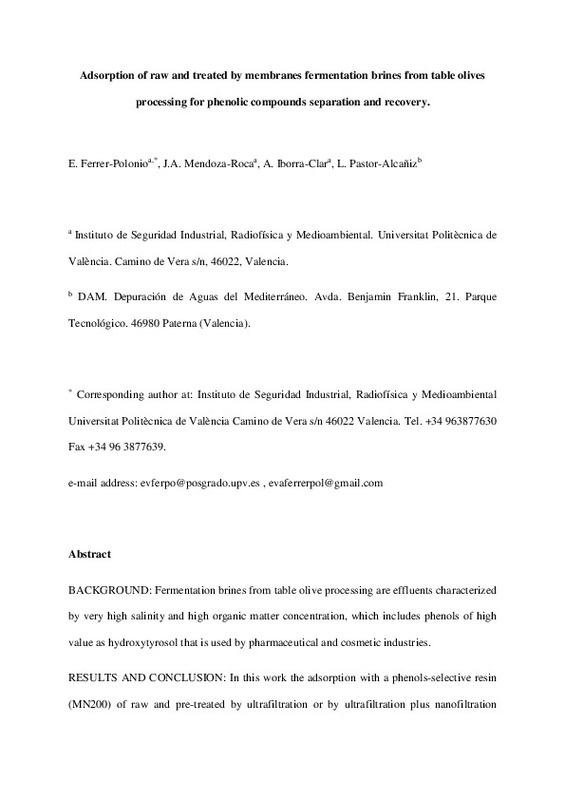JavaScript is disabled for your browser. Some features of this site may not work without it.
Buscar en RiuNet
Listar
Mi cuenta
Estadísticas
Ayuda RiuNet
Admin. UPV
Adsorption of raw and treated by membranes fermentation brines from table olives processing for phenolic compounds separation and recovery
Mostrar el registro sencillo del ítem
Ficheros en el ítem
| dc.contributor.author | Ferrer-Polonio, Eva
|
es_ES |
| dc.contributor.author | Mendoza Roca, José Antonio
|
es_ES |
| dc.contributor.author | Iborra Clar, Alicia
|
es_ES |
| dc.contributor.author | Pastor Alcañiz, Laura
|
es_ES |
| dc.date.accessioned | 2017-05-15T14:11:39Z | |
| dc.date.available | 2017-05-15T14:11:39Z | |
| dc.date.issued | 2016-07 | |
| dc.identifier.issn | 0268-2575 | |
| dc.identifier.uri | http://hdl.handle.net/10251/81136 | |
| dc.description.abstract | BACKGROUND: Fermentation brines from table olive processing are effluents characterized by very high salinity and high organic matter concentration, which includes phenols of high value as hydroxytyrosol that is used by pharmaceutical and cosmetic industries. RESULTS: In thiswork the adsorptionwith a phenols-selective resin (MN200) of fermentation brine (rawand pre-treated by ultrafiltration or by ultrafiltration plus nanofiltration) has been studied. The study included the adsorption and desorption process, and the useful life of the resin was evaluated. Results indicated that resin MN200 above 20 g L−1 yielded phenols separation efficiencies higher than 90%. However, the adsorption of nanofiltrated effluent separated phenols more selectively. Adsorption kinetics fitted properly to a pseudo-second-order kinetics and the Langmuir isotherm correctly model the adsorption process. Results of the intra-particle diffusion model show that the pore diffusion is not the only rate limiting step. Desorption was carried outwith ethanol. More than85%of phenolic compoundswere recovered. The use of the resin during ten cycles showed that the nanofiltrated effluent increased the useful time of the resin. CONCLUSION: The MN200 resin was a viable alternative to phenols removing and further recovering, in FTOP effluents. The optimal conditions were obtained for nanofiltrated effluents. | es_ES |
| dc.description.sponsorship | The authors of this work acknowledge the financial support of CDTI (Centre for Industrial Technological Development) through the Spanish Ministry of Science and Innovation. | en_EN |
| dc.language | Inglés | es_ES |
| dc.publisher | Wiley | es_ES |
| dc.relation.ispartof | Journal of Chemical Technology and Biotechnology | es_ES |
| dc.rights | Reserva de todos los derechos | es_ES |
| dc.subject | Fermentation brines | es_ES |
| dc.subject | Phenols adsorption | es_ES |
| dc.subject | Phenols recovery | es_ES |
| dc.subject | Polymeric resin | es_ES |
| dc.subject | Table olive processing | es_ES |
| dc.subject.classification | INGENIERIA QUIMICA | es_ES |
| dc.title | Adsorption of raw and treated by membranes fermentation brines from table olives processing for phenolic compounds separation and recovery | es_ES |
| dc.type | Artículo | es_ES |
| dc.identifier.doi | 10.1002/jctb.4807 | |
| dc.rights.accessRights | Abierto | es_ES |
| dc.contributor.affiliation | Universitat Politècnica de València. Instituto de Seguridad Industrial, Radiofísica y Medioambiental - Institut de Seguretat Industrial, Radiofísica i Mediambiental | es_ES |
| dc.contributor.affiliation | Universitat Politècnica de València. Escuela Técnica Superior de Ingenieros Industriales - Escola Tècnica Superior d'Enginyers Industrials | es_ES |
| dc.contributor.affiliation | Universitat Politècnica de València. Escuela Técnica Superior de Ingeniería del Diseño - Escola Tècnica Superior d'Enginyeria del Disseny | es_ES |
| dc.contributor.affiliation | Universitat Politècnica de València. Departamento de Ingeniería Hidráulica y Medio Ambiente - Departament d'Enginyeria Hidràulica i Medi Ambient | es_ES |
| dc.description.bibliographicCitation | Ferrer-Polonio, E.; Mendoza Roca, JA.; Iborra Clar, A.; Pastor Alcañiz, L. (2016). Adsorption of raw and treated by membranes fermentation brines from table olives processing for phenolic compounds separation and recovery. Journal of Chemical Technology and Biotechnology. 91(7):2094-2102. doi:10.1002/jctb.4807 | es_ES |
| dc.description.accrualMethod | S | es_ES |
| dc.relation.publisherversion | http://dx.doi.org/10.1002/jctb.4807 | es_ES |
| dc.description.upvformatpinicio | 2094 | es_ES |
| dc.description.upvformatpfin | 2102 | es_ES |
| dc.type.version | info:eu-repo/semantics/publishedVersion | es_ES |
| dc.description.volume | 91 | es_ES |
| dc.description.issue | 7 | es_ES |
| dc.relation.senia | 322797 | es_ES |
| dc.identifier.eissn | 1097-4660 | |
| dc.contributor.funder | Ministerio de Ciencia e Innovación; Centro para el Desarrollo Tecnológico Industrial | es_ES |






![[Cerrado]](/themes/UPV/images/candado.png)


